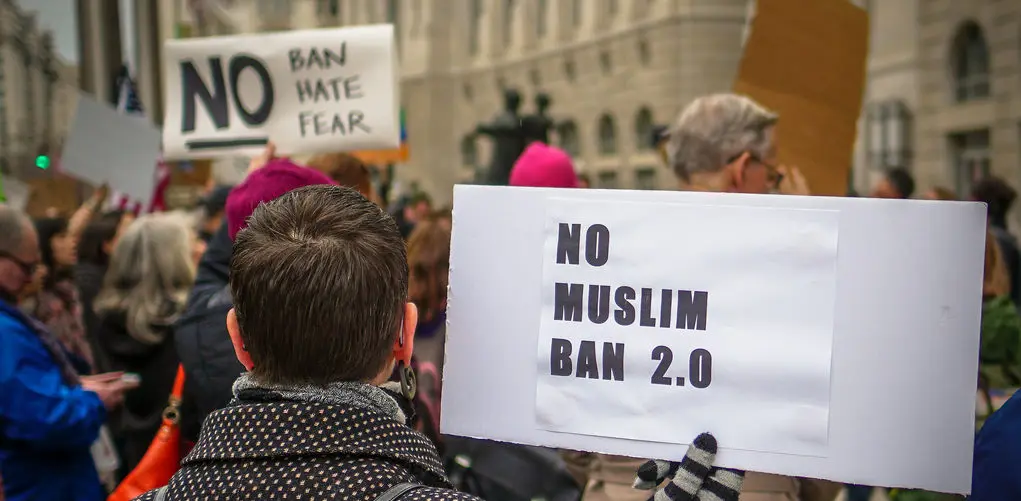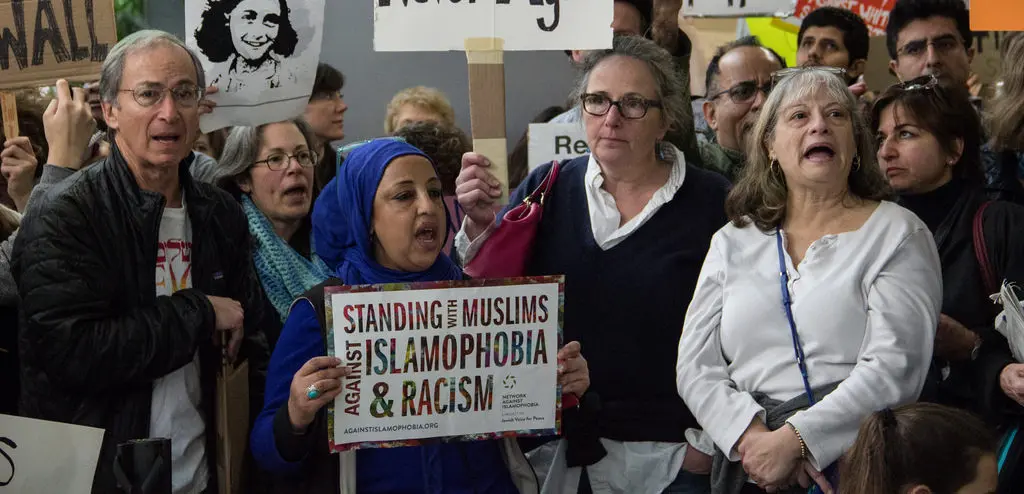The Path to the Muslim Ban
Earlier this week, we were dealt a devastating blow when the U.S. Supreme Court issued a ruling upholding Trump’s Muslim Ban and paving the way for the President and the Executive to expand and enact more bigoted policies.
We know from our history that the U.S. Supreme Court has made mistakes before. We’ve seen them uphold slavery in the Dred Scott v. Sandford case in 1957. In 1944, they allowed for the imprisonment of 120,000 American citizens, solely on the basis of their Japanese ancestry. And this week, they made another mistake in allowing Trump’s bigoted, Islamophobic executive order to stand.
For more background on the road leading up to the Muslim Ban, read the timeline below.
January 2017
President Donald Trump issues Executive Order 13769, also known as EO-1, the travel ban, or “Muslim Ban,” with the stated purpose to be to defend the United States against terrorism. The order applies immigration restrictions on foreign nationals from seven Muslim-majority countries: Iran, Iraq, Sudan, Somalia, Syria, Yemen, and Libya. Restrictions include halting issuance of certain visas and suspension of entry for 90 days to migrants and non-migrant foreign nationals from the specified countries. The order also completely bars entry of Syrian refugees to the United States for the duration of the order as well as limited the number of refugees accepted to 50,000 for 2017.
February 2017
The Court issues a judgement in a related case barring application of Section 2(c) of the order which specified suspension of entry of foreign nationals.
March 2017
President Trump issues Executive order 13780, also known as EO-2 or “Muslim Ban 2.0,” as a revisionary directive to the original order. The order questions if certain foreign governments cooperate in disclosing information about their citizens attempting to migrate to the United States, citing lack of cooperation as a security threat. Foreign nationals from six out of the original seven countries, Iraq being excluded in this revision, are barred from entry to the United States for 90 days.
The State of Hawaii files civil action to halt the order, alleging it violates the First Amendment Establishment Clause and the Immigration and Nationality Act among others. The First Amendment Establishment Clause states that “Congress shall make no law respecting an establishment of religion, or prohibiting the free exercise thereof.” The Immigration and Nationality Act removed discrimination in immigration policy based on race and nationality. The Court ultimately rules to uphold the injunction against the order with minor exceptions.

June 2017
The administration petitions the injunction issued prior. A panel of judges rule to uphold the injunction having found (1) President Trump to have overreached broad authority over immigration, (2) the order to have violated laws that prohibit nationality-based discrimination, and (3) President Trump to have not followed appropriate process to institute limit on admission of refugees. The United States Supreme Court issues ruling stating the travel ban could not be enforced on foreign nationals or refugees who have a credible claim and a proven documented relationship with a person or entity in the United States.
September 2017
President Trump issues Presidential Proclamation No. 9645 on the day EO-2 was set to expire. The Proclamation imposes an indefinite travel ban on eight countries, five of which were previously listed in the original orders: Iran, Syria, Libya, Somalia, Yemen, Chad, North Korea, and Venezuela. Hawaii files a lawsuit opposing ban.
October 2017
The judge issues a temporary restraining order preventing the Proclamation from being enforced against all countries but North Korea and Venezuela.
December 2017
The Court grants the administration’s appeal, allowing for the Proclamation to be applied in full effect while the case is pending. The US Court of Appeals upholds injunction, maintaining that the Proclamation exceeds the scope of the President’s authority and probably violates the Immigration and Nationality Act.

January 2018
The administration petitions the Supreme Court, saying the injunction was overly broad and it halted important national security measures. The State of Hawaii and the administration argue over whether the Proclamation violates the Establishment Clause of the First Amendment.
The government argues that The Proclamation does not violate the First Amendment because there is no mention of religion in the text of the Proclamation and it the countries listed are those countries that has a high rate of terrorism and they do not provide adequate information to determine whether or not its citizens are admissible to the United States. They also argue that Iraq, a country that is predominately Muslim, was also on the list but was removed because of their democratic state, the presence of United States military in Iraq and Iraq is an ally in the fight against ISIS. Trump stated that because Iraq has been removed from the list, further suggest that this is about national security and not about keeping out Muslim immigrants.
Hawaii, argues despite the fact Iraq was removed from the list, this Proclamation is still about keeping Muslims from immigrating to the United States. Trump has made comments about how he wants to keep out Muslims before EO-1 and 2 were executed. By keeping Muslims from entering into the country is a direct violation of the Establishment Clause, which states that Congress may not establish a national religion or preference one religion over the other. Banning Muslims does exactly that—preferences one religion (any religion other than Islam) over Islam and it is the start of establishing a national religion.
February 2018
The Court sets the argument date for April 25, 2018.
April 2018
Both parties argue their cases. The administration argues that immigration falls under presidential authority and upholding the order is a matter of national security. Hawaii argues that given the history of the Proclamation and previous orders, the law is discriminatorily motivated, violates laws, and is overreaching of authority.
The First Amendment prohibits states establishment of religion, meaning Congress cannot establish a national religion or preference one religion over another. The Proclamation targets those countries that are predominately Muslim, preventing them from entering the United States. Prior to and during Trump’s presidency, he has made many comments about limiting Muslim immigration to the United States, and even stated via social medial that he would have a stronger version of the ban that was not “politically correct.” Even members of Trump’s staff have made comments about keeping out Muslims and initiating a “Muslim Ban.” In regard to Venezuela and North Korea also being on the list, citizens from both countries are already prohibited from entering into the country under other sanctions not relevant to the other countries listed on the list. This is evidence that the Proclamation is discriminatory in nature, based on religion, and is not about entirely about national security as the Government argues.
The Government states The Proclamation is not discriminatory in anyway because there is no mention of religion in the language of the text, includes several non-Muslim countries and was the result of interagency review. The government even stated that Iraq, a predominately Muslim country was on the list but was removed due to them being an ally and the presence of United States military in the country, proves that this is not about banning Muslims. Trump has stated that anything his staff members or himself have said prior to the signing of The Proclamation, had nothing to do with this ban and does not suggest any anti-Muslim bias. The Government maintains its position that these countries were not placed on the list because they do not offer the information needed to determine if those immigrants are able to be admitted into the country, which is a national security issue.
June 2018
The Supreme Court upholds the Muslim Ban as a constitutional exercise of Presidential authority. In their 5-4 decision, the Court applied a very deferential rational-basis test to the president’s actions and rejected the Plaintiffs’ arguments that Trump’s statements during the campaign were strong enough indicia of an improper religiously-motivated animus. In her dissent, Justice Sonia Sotomayor laments that the court has blindly endorsed “a discriminatory policy motivated by animosity toward” Muslims and that the decision reflects some of the same problematic arguments underlying Korematsu, which upheld the internment of Japanese American citizens during World War II.
*NOTE: further analysis will be forthcoming as our Civil Rights Department studies the text of the decision in full.

